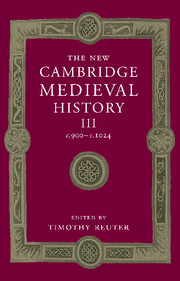Book contents
- Frontmatter
- 1 Introduction: reading the tenth century
- PART I GENERAL THEMES
- PART II POST-CAROLINGIAN EUROPE
- PART III NON-CAROLINGIAN EUROPE
- 19 European Russia, c. 500–c. 1050
- 20 Bohemia and Poland: two examples of successful western Slavonic state-formation
- 21 Hungary
- 22 Byzantium in equilibrium, 886–944
- 23 Bulgaria: the other Balkan ‘empire’
- 24 Byzantium expanding, 944–1025
- 25 Byzantium and the West
- 26 Southern Italy in the tenth century
- 27 Sicily and al-Andalus under Muslim rule
- 28 The Spanish kingdoms
- Appendix genealogical tables
- List of primary sources
- Bibliography of secondary works arranged by chapter
- Index
- Frontispiece
- Plate section
- Map 2: Archbishoprics and bishoprics in the early eleventh century
- Map 4: Germany
- Map 13: Byzantium in 1025
- References
19 - European Russia, c. 500–c. 1050
from PART III - NON-CAROLINGIAN EUROPE
Published online by Cambridge University Press: 28 March 2008
- Frontmatter
- 1 Introduction: reading the tenth century
- PART I GENERAL THEMES
- PART II POST-CAROLINGIAN EUROPE
- PART III NON-CAROLINGIAN EUROPE
- 19 European Russia, c. 500–c. 1050
- 20 Bohemia and Poland: two examples of successful western Slavonic state-formation
- 21 Hungary
- 22 Byzantium in equilibrium, 886–944
- 23 Bulgaria: the other Balkan ‘empire’
- 24 Byzantium expanding, 944–1025
- 25 Byzantium and the West
- 26 Southern Italy in the tenth century
- 27 Sicily and al-Andalus under Muslim rule
- 28 The Spanish kingdoms
- Appendix genealogical tables
- List of primary sources
- Bibliography of secondary works arranged by chapter
- Index
- Frontispiece
- Plate section
- Map 2: Archbishoprics and bishoprics in the early eleventh century
- Map 4: Germany
- Map 13: Byzantium in 1025
- References
Summary
introduction
Histories of European Russia during the early medieval era normally focus upon the origins and development of the Rus′ state centred at Kiev. This approach is, however, much too parochial. Politically, it ignores the Byzantine Crimea, the Khazar khaganate, and the Volga Bulgar amirate, the non-Rus′ states which existed in European Russia after 500 ad. Socially, it omits the vast majority of the population who did not belong to the ruling elites of these states. In order to reflect these new historical perspectives, this chapter will focus on two major themes: the peoples who inhabited European Russia and the states which sought to govern these peoples.
First, however, a few comments about terminology are necessary. There are no universally accepted terms in English for what is referred to here as European Russia. Most Soviet scholars used the phrase eastern Europe (Vostochnaia Evropa), which is fine except that many in the west consider Poland, the Czech Republic, Hungary and the Balkans as eastern Europe. On the other hand, Ukrainians and other non-Russians object to being classified as part of Russia, even if only for geographical purposes. With apologies to the non-Russians, European Russia has been adopted because it best describes in English the region being examined here. Great controversy also surrounds the use of the word Russian to describe the eastern Slavs and their state in the pre-Mongol era. Ukrainian scholars in particular have insisted that Rus′ is a far better term, especially since it was the word most used by the medieval east Slavic sources to denote themselves and their state. Since this argument has much merit, the term Rus′ will be employed here.
Keywords
- Type
- Chapter
- Information
- The New Cambridge Medieval History , pp. 485 - 513Publisher: Cambridge University PressPrint publication year: 2000
References
- 2
- Cited by



